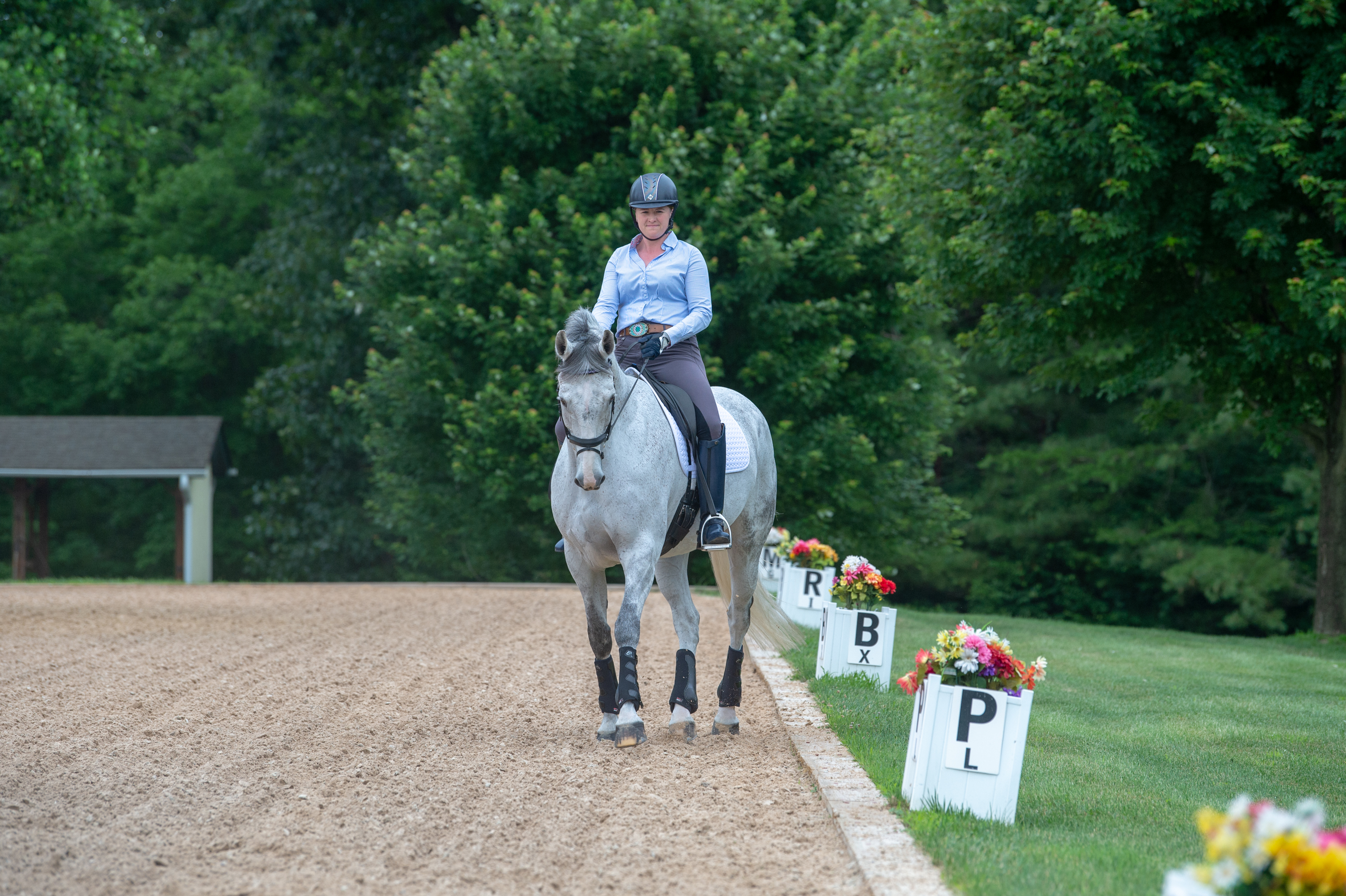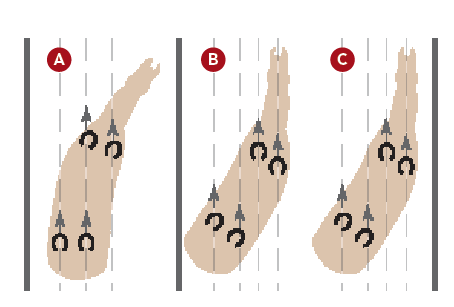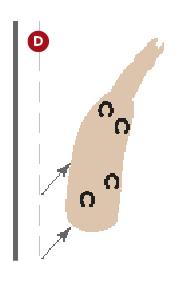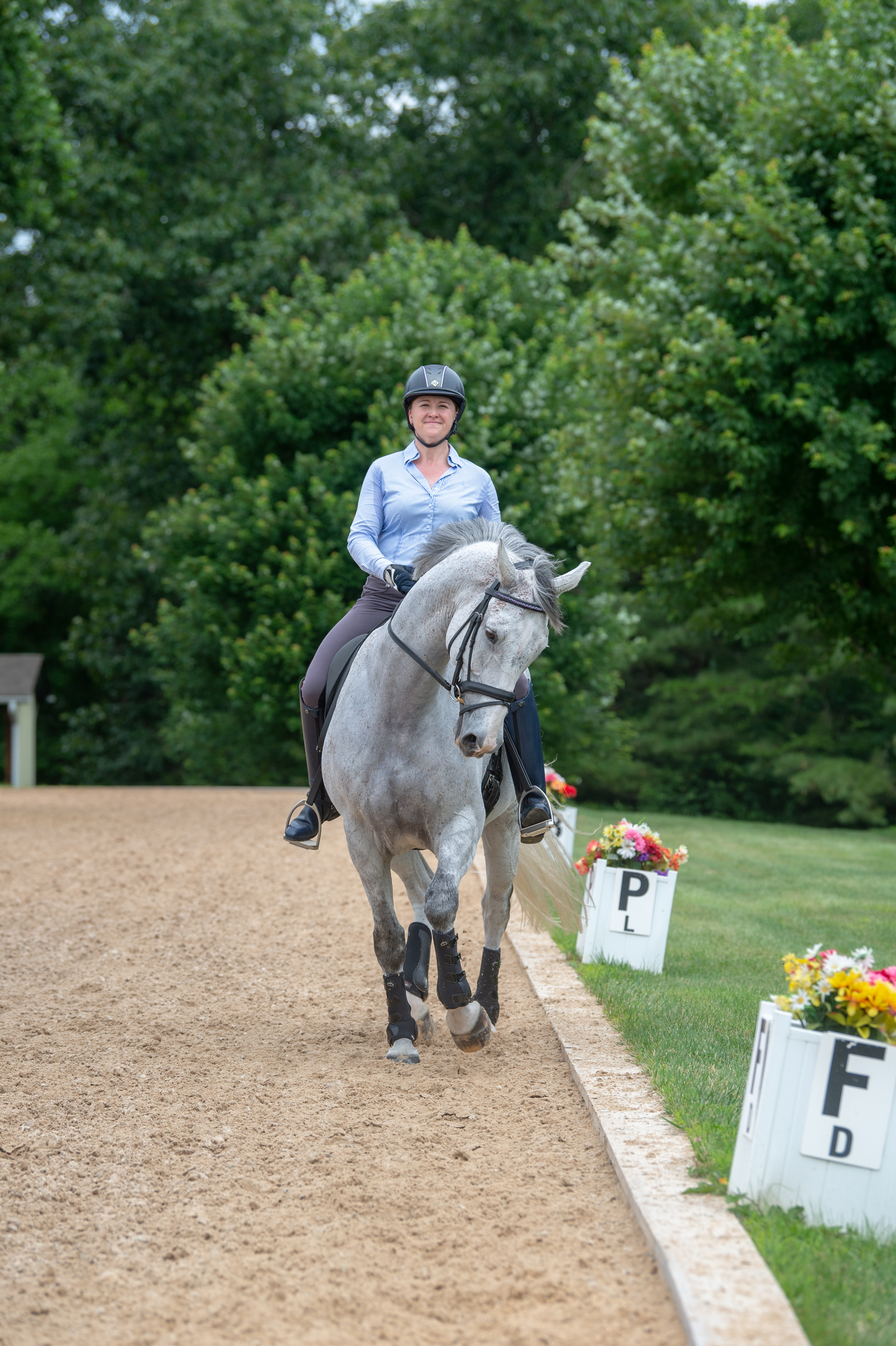The shoulder-in’s fickle and elusive cousin, the renvers, positions the horse’s body in a similar way relative to the rail, but asks him to bend in the opposite direction.

In a correctly ridden renvers, the horse’s shoulders move to the inside, off the rail, while the haunches continue to travel along the rail. Unlike the shoulder-in, however, where the bend is toward the inside of the riding arena, the horse’s body bends toward the outside of the arena in the renvers, and his chest faces forward, at a right angle to the long side. Whereas the shoulder-in is performed on three tracks, the renvers is performed on four tracks. The horse’s front legs follow their own individual tracks, which are both to the inside of the two tracks of the hind legs (see diagram). The angle his body makes with the rail should be about 35 degrees.

C) Haunches-In/travers LEFT (tracking left) is the same as a renvers, but it is ridden on the opposite side of the arena.

More simply put, renvers is the same as a haunches-in, or travers, ridden on the opposite side of the arena. For example, when tracking to the right, the shape of your horse’s body in a renvers (called a “renvers left,” because the horse’s body is bent to the left) is basically the same as it is in a haunches-in performed when tracking left (“travers left”).
While your horse’s body position in the renvers and travers is identical, the execution of the renvers makes it a more challenging movement. Out of habit, he’ll want to assume a bend toward the inside of the arena. You have to work harder to keep him balanced when asking him to bend to the outside instead, thus separating the direction of bend from the direction of travel. Correctly executing a renvers, therefore, is an exercise in control over your horse’s whole body.
Renvers is nowhere to be found in the FEI tests or eventing dressage tests. It makes only one appearance in the 2019 U.S. Equestrian Federation dressage tests—in Third Level, Test 2. But don’t take renvers for granted. It’s a movement that will set you up for canter half-pass zigzags and prove to be a useful tool for teaching clean flying changes.
Why love the renvers? It’s a tricky movement to ride well in and of itself: tricky to enter, tricky to exit and tricky to not end up wandering off the rail. It’s also deliciously tricky to transition into and out of the renvers from the shoulder-in (see photos below). When you feel like you can go back and forth between these two movements at the trot, you’ll know your horse is really honest in his uphill and upright balance. Being able to successfully transition from shoulder-in to renvers without his body wiggling around during the change of bend demonstrates tremendous control of his midsection and shoulders. It particularly shows your ability to encourage him to lift both the right and left sides of his rib cage to produce equally good bends to the right and left, respectively. When you can address the sides of the horse this way and influence his ability to lift them individually, it becomes much easier to ask him to lift both sides simultaneously, to produce more engaged and collected work, such as pirouettes, flying changes, steeper lateral work (such as half-passes ridden on a more angled track across the arena, thus requiring more dramatic leg cross-over), and even piaffe and passage.
In the canter, the renvers is a terrific tool to help address problems with the flying changes. Many horses like to change late behind (change leads in the hind legs after changing leads in the front legs, instead of changing them at the same time). When you ask your horse to adopt renvers before initiating a flying change, he has a clearer path to jump the new inside hind leg up under his body in the change. For example, if you’re cantering on the right lead and perform a renvers left—bringing his shoulders in off the rail and bending his body to the left—his right hind leg will be positioned more under his body, making it easier to control, and his left hind leg will be bearing less of his body weight, and thus more able to jump up and forward during the change to the left lead. This position also makes it just a bit harder for his front legs to jump off the ground, so they’re less likely to change ahead of the hind legs. Together, these effects result in a cleaner change.
The control gained by mastering renvers can also be helpful in improving the canter half-pass zigzags required at the upper levels, in which you half-pass in one direction, then make a flying change before half-passing in the other direction. Changing the bend before changing the lead helps your horse position himself correctly for the direction of the next half-pass. It can also help horses who want to “jump the gun” in the zigzag and change leads too soon; when you can successfully change the bend and directionality of the shoulders in the canter before executing the change, it encourages patience—and demonstrates great obedience—in your horse.
Execute a Correct Renvers
Here’s how to properly perform a renvers left on the long side of the arena:
1. Tracking right, I ride through the corner in a collected trot, straighten for a few steps, and then wrap my left leg around my horse and squeeze with my ankle and lower calf to create the left bend, telling Dorian to lift his outside ribcage and contract his outside abdominal muscles. My right leg slides ever so slightly back, to keep the haunches on the track. It needs to be strongly in place before the renvers begins.

2. Next, I bring both my hands to the right to invite Dorian’s shoulders to come in off the rail, slightly bending my left wrist to ensure I have a bit of left flexion of the poll. I also allow my right elbow to push forward toward the bit to allow my horse to “grow” that side of the neck through the bend.

3. I do not change much of my balance in my hips, but instead stay sitting fairly in the middle of the horse, or maybe just a bit into my left hip to help encourage the haunches to stay on the track. Remember, in renvers, the horse’s haunches should stay on the track on which he began, not fall in to follow the shoulders. My shoulders continue to stay square and facing down the long side, to mirror Dorian’s shoulders, which also stay pointing straight ahead.

4. To complete the exercise, I return my hands to neutral on both sides of Dorian’s neck, and return my inside (right) leg to the girth to release the bend. As a result, Dorian is straight before I ride the corner.

Common Mistakes in Renvers
Too much angle. The angle your horse’s body makes with the wall should not be greater than about 35 degrees. Competition rules dictate that the exercise is ridden on four tracks, but those four tracks should not be too wide, as that makes it difficult for the horse to remain connected through his body from his haunches, over the back to the bridle.

Not enough bend. Because of its similar body position to shoulder-in—with the shoulders to the inside of the haunches—some riders will not create sufficient bend toward the outside of the arena in their renvers and, as a result, the movement ends up as more of a leg-yield down the long side than a proper renvers.

Too much bend in neck, not enough bend in body; not enough angle. Some riders simply pull the horse’s head to the outside in an attempt to create the outside bend, but bend comes from the ribcage. Attempting renvers this way usually results in the shoulders falling too far in, or the entire body falling in, both of which disrupt the rider’s control of the horse’s whole body and are incorrect.

Shoulder-in to Renvers to Shoulder-In
In this example, Dorian and I demonstrate how to perform a shoulder-in right, directly followed by a renvers left, which is then directly followed by another shoulder-in right.
1. We begin the shoulder-in in the corner. I bring my hands slightly to the inside while the rest of my torso stays facing down the long side. My inside (right) leg is on at the girth, with my outside (left) leg slightly back to prevent Dorian’s haunches from falling out.

2. Next, I begin to change to the outside bend without changing Dorian’s angle relative to the rail. I slide my right leg back to prevent his haunches from falling in, while sliding my left leg forward to cultivate bend through the outside ribcage.

3. I bring my hands slightly more to the inside than I did in shoulder-in to move the shoulders just a bit more off the rail. Note how Dorian’s shoulders are slightly more to the inside of his haunches here in renvers than they were in shoulder-in. That’s because this is a four-track movement, whereas the shoulder-in is a three-track movement.

4. Finally, I change back to the inside bend and the shoulder-in. I slide my inside (right) leg forward to the girth to create the new bend, and my outside (left) leg back behind the girth to prevent Dorian from stepping out with the haunches. To return his shoulders to a three-track alignment, I move my hands slightly less to the inside.

This article first appeared in the Spring 2020 issue of Practical Horseman magazine.
Click here to read more articles with Lauren Sprieser.

Originally from Oak Brook, Illinois, Lauren Sprieser made her first foray into international-level dressage at the age of 18, under the tutelage of Lendon Gray. She competed in three North American Junior & Young Rider Championships, winning two team medals, and three U.S. Equestrian Federation Young Adult “Brentina Cup” National Championships, and earned her U.S. Dressage Federation gold, silver and bronze medals—all before her 21st birthday. Now running her own business, Sprieser Sporthorse, in Marshall, Virginia, she produces FEI horses and trains riders of all levels and disciplines. She and her most recent Grand Prix partner, Ellegria, earned top Grand Prix and Freestyle placings at the 2015 and 2016 USDF Finals and third place at the 2016 CDI**** World Cup Test Event in Omaha.











